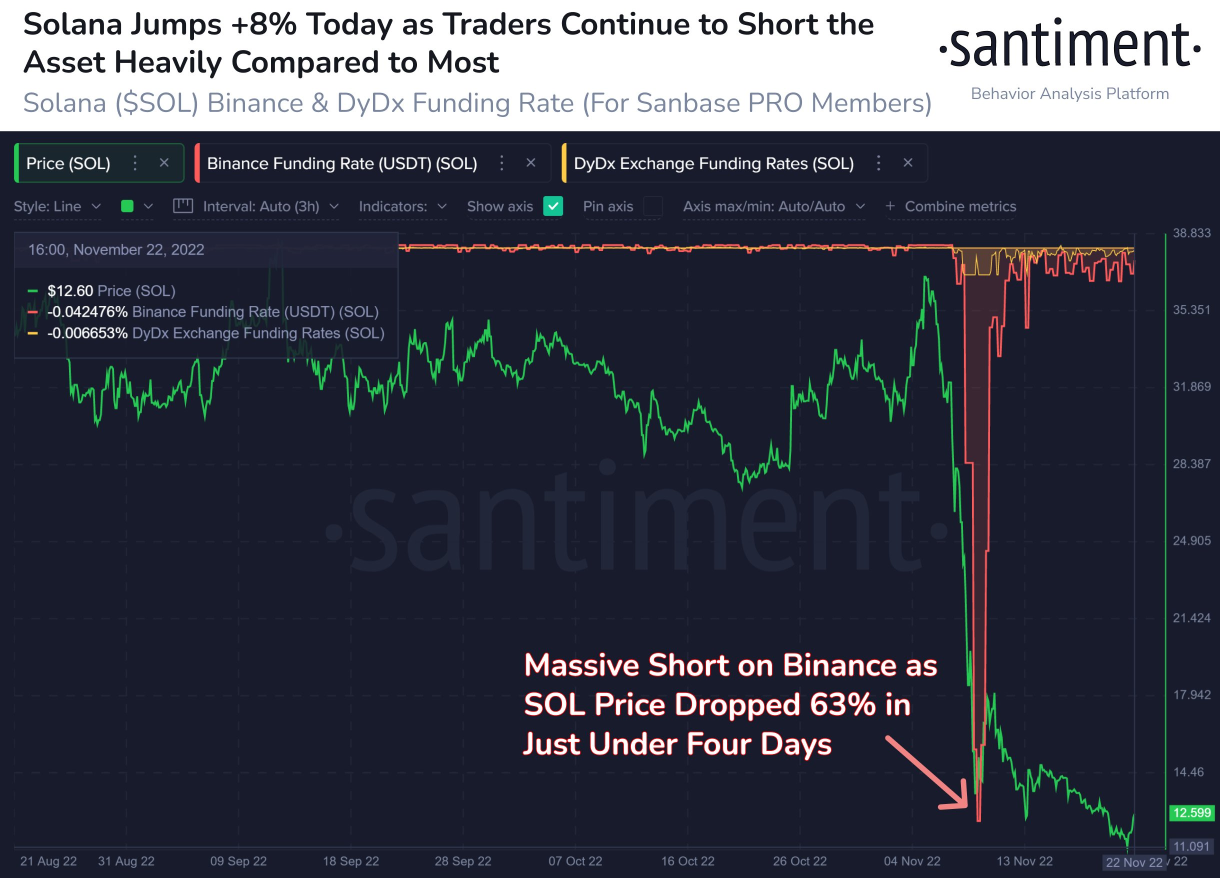Solana after FTX’s collapse. What will happen to the ecosystem and the price of SOL
How the collapse of the native token’s price and other problems will affect the development of the project

25.11.2022
1662
7 min
3
The former CEO of the bankrupt FTX exchange Sam Bankman-Fried called Solana “the most underrated token” and repeatedly pointed to its growth potential. The collapse of Fried’s crypto empire, considered one of the main pillars of support for the Solana ecosystem, led to the collapse of its native token price and called into question the further development of projects running on its blockchain.
When FTX’s bankruptcy was confirmed, the price of Solana’s (SOL) native token collapsed by more than 40%. According to analysts at Santiment, Solana has fewer and fewer people who believe strongly in the project, despite the rebound of the SOL price from the bottom at $11,02. According to the experts, “fear, uncertainty and doubt” (FUD) could cause an even bigger rebound until traders slow their bets against the SOL price. A massive shorting of the asset was recorded on the Binance crypto exchange on November 22, when its price fell by 63% in just under four days.

On November 24, the Solana Foundationpublished a report revealing that it held about $1 million in fiat and equivalents on FTX. The text of the report emphasizes that the collapse of the exchange does not have a significant impact on the project, as this amount is less than 1% of its assets.
While the organization did not store SOL coins on FTX, about 3,43 million FTX’s (FTT) tokens and 134,54 million Serum (SRM) tokens owned by the fund are currently locked on the exchange. SRM was also among the most liquid of FTX’s remaining assets at the time of its bankruptcy, according to internal documentation that surfaced in the media.
Why the price collapsed
Solana’s connection with the FTX conglomerate is quite obvious, says Nikita Zuborev, senior analyst at Bestchange.ru. The FTX exchange and the Alameda fund were major partners in the project and actively supported its infrastructure. Zuborev lists Serum (SRM), MAPS (MAPS), and Oxygen (OXY) among the projects in the Solana ecosystem that received funding from Alameda, adding that FTX was actually the largest gateway for value transfer between Solana and the rest of the blockchain.
After the Solana ecosystem lost support and investment from FTX, it took a toll on the project’s reputation and caused secondary problems. Against this backdrop, there were massive sell-offs of SOL tokens, which, in turn, collapsed its price. Such a self-sustained fall also negatively affects the future of the project and provokes investors to get rid of the asset, the analyst explains.
According to financial records released by Coindesk in the days before the collapse of FTX, SOL tokens were a significant part of the reserves of FTX and Alameda Research. When both companies began to have liquidity problems, investors logically assumed that both companies would try to make up for the lack of liquidity by selling some of the assets they have in reserve, explains co-founder of ENCRY Foundation Roman Nekrasov.
Part of the assets in the company’s reserves were pledged and did not have high liquidity, and the main part of them consisted of their own token FTT. According to Nekrasov, the news of this provoked the idea in the market that FTX and Alameda will start selling their existing tokens SOL (about 50,5 million). If a lot of SOL coins enter the market at once, there will be a surplus and the price of the asset will fall, the expert explains.
“Every investor thought that he would have time to sell his SOL coins before the price would fall heavily. Thus, the flight of capital from SOL only worsened, because FTX and Alameda did not have time to sell something from their reserves,” Nekrasov describes the reasons for the collapse of the token price.
Not too stable
A few days after FTX Group announced its bankruptcy, two crypto exchanges announced imposing restrictions on USD Coin (USDC) and Tether (USDT) stablecoins on the Solana blockchain. Binance suspended accepting deposits from November 17, and OKX announced it was delisting both stablecoins.
Tether assured that the bankrupt Alameda Research and its connection to the Solana blockchain would not affect the centralized stablecoin USDT. However, on November 21, Tether announced a $1 billion USDT transfer from the Solana blockchain to the Ethereum (ETH) network.
In few minutes Tether will coordinate with a 3rd party to perform a chain swap, converting from Solana to Ethereum ERC20, for 1B USDt. The #tether total supply will not change during this process.Learn more about chain swaps ⬇️https://t.co/abfgnELSvi — Tether (@Tether_to) November 18, 2022
“In fact, the scandal started on nothing. If we consider the real risks for stablecoins on the Solana network, they are no greater than in any other ecosystem,” comments Zuborev, explaining that infrastructurally Solana was in no way involved in the issuance of such tokens. For example, USDT is a purely private token and depends solely on Tether, so there are no financial risks to depeg the USDT price on any blockchain due to their internal problems, the analyst explains.
According to Zuborev’s observations, when Binance announced the suspension of USDC and USDT deposits on the Solana blockchain without explanation, it provoked panic, after which other exchanges (OKX, Bybit, BitMEX, KuCoin, MXC, Crypto.com, and others) began to freeze token acceptance, despite Tether itself assuring that there were no risks.
Tether’s decision to cut in half the token’s issuance on the Solana blockchain by moving a billion tokens to Ethereum, while not directly affecting DeFi’s future prospects within Solana, is a serious reputational blow to the ecosystem. This reduction in the presence of large companies and the reduced liquidity of assets within the blockchain calls into question the future of the entire ecosystem, including the decentralized applications (dApps) present in it, Bestchange.ru’s analyst believes.
What will happen to the projects
Because the Solana Foundation and Solana Labs did not immediately publish an explanation of how much Solana depends on FTX, the entire Solana ecosystem has suffered from capital flight, Nekrasov believes. For example, NFT collections on the Solana blockchain have fallen more in value as a percentage than those issued on Ethereum.
“Market participants feared that Solana, which is trying to compete with Ethereum, having lost one of its key supporters in the form of FTX and Alameda, would stall development, and possibly collapse altogether. It didn’t happen, but, obviously, the blow was dealt a strong blow,” the ENCRY Foundation representative comments. According to Nekrasov, the emergence of new DeFi protocols on Solana will slow down because the flow of liquidity has greatly decreased.
A variety of technical innovations allow Solana to be one of the most promising blockchains in terms of potential scalability, Zuborev comments when asked about the technical side of Solana.
“The speed of transaction processing allows it to compete with centralized services, but at the same time, it seems to be the most frequent guest of news headlines about network suspensions for several hours,” the analyst adds, recalling also that Solana has been in test network mode for years, which means that all services running on the SOL blockchain are also subject to failures and downtime.
The project has a lot of problems, and the lack of funding for future developments due to the loss of the main investor, and reputational losses due to close financial ties could actually destroy Solana, despite many useful technical initiatives, Zuborev believes. On the other hand, the really serious projects will move their development to other blockchains and continue to develop even in the most negative scenario for the ecosystem.
Useful material?
Articles
How the largest cryptocurrency exchange’s initiatives help it maintain its leadership
Nov 19, 2022
Articles
What fan coins are needed for and what events contribute to their growth
Nov 16, 2022
Articles
Why Binance set the trend to publish transparent data on available funds
Nov 14, 2022
Articles
The journalists got acquainted with the documents revealing the details of the financial condition of the exchange
Nov 13, 2022
Articles
Desperate traders with stuck assets resort to semi-legal schemes to save deposits
Nov 11, 2022
Articles
Experts predict when to expect new peaks of the crypto market by analyzing its previous cycles
Nov 10, 2022









 Telegram
Telegram  Twitter
Twitter